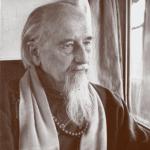Lama Anagarika Govinda, the Founder of the Order
Lama Anagarika Govinda (1898-1985) devoted his whole life to making the wisdom treasures of the East accessible to Western-influenced people. As a practitioner, researcher, author, artist, and teacher, he strongly influenced the perception of Buddhism in America and Europe. His works have been translated into many languages and his autobiography "The Path of the White Clouds" is still a spiritual companion to many seekers.
Lama Govinda was born as Ernst Lothar Hoffmann in Germany. After studying archeology and philosophy, he worked on archeological research in the Mediterranean. In order to devote himself entirely to the study and practice of Buddhism, he settled in Ceylon in 1928 and became a pupil of the German Theravada monk and scholar Ven. Nyanatiloka. As a delegate of Theravada Buddhism, he participated in a conference in Darjeeling.
His encounter with Tomo Geshe Rinpoche, a true master of Tantric Buddhism, changed his previous Buddhist orientation. Lama Govinda became his disciple and settled near his monastery at the foot of the Himalayas. As a painter, researcher, writer, scholar and lecturer at various universities he gained prestige and honors in Indian society. Traveling to Sikkim, Ladakh, Southern and Western Tibet, he explored the culture and practice of Vajrayāna Buddhism.
In 1933 he was commissioned by Tomo Geshe Rinpoche to found the Order of Arya Maitreya Mandala. Its activities were intended to give new impetus to Buddhism in India. The Second World War and India's struggle for independence interrupted Lama Govinda's dedicated work. Although a British citizen, he was held in detention for five years. Completely destitute, he then had to laboriously rebuild his existence.
From 1947 to 1949 he undertook an expedition to the Tibetan highlands to document the frescoes in Tsaparang Monastery. Lama Govinda received teachings and initiations from various lineages and schools of Tibetan Buddhism. He published the treasures of his research and meditation experiences in his main work "Fundamentals of Tibetan Mysticism". It is translated into many languages and it fundamentally revolutionized the image of Tibetan Buddhism in the West.
As a result, he received invitations to lecture from all over the world. In many places where Lama Govinda lectured, groups emerged, based on his understanding of Buddhism. In 1952 the Western European branch of the Order Arya Maitreya Mandala was founded in Germany, followed a short time later by the Eastern European branch in Hungary.
Many people visited Lama Govinda in his "Kasar Devi Ashram" near Almora in northern India to learn from him. Lama Govinda tought a Buddhist understanding, which includes all stages of the development of Buddhism through an intensive study of sources. He provided us with in-depth knowledge of the Buddhist path, its rituals and symbols, its art and culture. In his research, he penetrated the outer, historically and culturally conditioned forms in order to expose their timeless essence of wisdom. This deepest dimension reveals itself only through meditation.
We are urged to do the same as Lama Govinda in order to keep this timeless heritage alive in new forms. At an advanced age, Lama Govinda moved to California with his wife Li Gotami. He tought, researched, lectured and published until the end of his life in January 1985.












